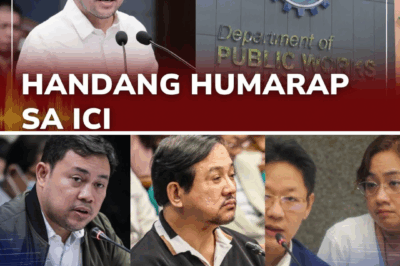The Day the AMLC Hammer Dropped: 164 Accounts Frozen
In a dramatic move that sent shockwaves through the Philippines’ political and financial establishment, the Anti-Money Laundering Council (AMLC) launched an unprecedented offensive against alleged systemic corruption. The target: the bank accounts of the Discaya couple and, crucially, their immediate family, including a nephew. The sheer scope of the operation is staggering—the AMLC issued a freeze order on 164 different bank accounts, effectively paralyzing an alleged financial network built on public funds.
This action is not merely a bureaucratic skirmish; it is a frontal assault on a network suspected of siphoning billions of pesos intended for vital national infrastructure. Specifically, the investigation is centered on funds related to flood control projects, raising the grim specter of corruption directly translating into human suffering and disaster during the nation’s increasingly severe rainy seasons.
The figures uncovered by the investigation are astounding: cumulative inflows into these linked accounts since 2016 reportedly reached ₱8.2 billion. However, the scandal’s true shadow looms over an estimated ₱180 billion in flood control funds—money meant to fortify the Philippines against natural disasters—now believed to have been systematically compromised. The AMLC’s intervention signals a potential legal reckoning for high-level officials and private figures who allegedly treated the public treasury as their private ATM, putting their own financial gain before the safety of millions of citizens.
Anatomy of a Multi-Billion Peso Heist: The ‘Royalty’ Scheme
The investigation has peeled back the layers on a sophisticated money laundering operation that allegedly operated with impunity for years. The method appears to revolve around a concept investigators have dubbed the “flood control royalty” scheme. While the term is deliberately vague, it clearly points to a system of large-scale kickbacks or illicit commissions paid out from government infrastructure contracts.
The money trail reveals a pattern of transactions designed to obscure the source of the funds and evade detection. The sheer volume of accounts—164 different receptacles—demonstrates a calculated effort to “structure” deposits and withdrawals to stay below legal reporting thresholds, making tracing the money difficult.
Further evidence of the operation’s audacity lies in the transaction records. Investigators flagged suspicious movements, including one bank account allegedly holding ₱51 million and an alarming ₱113 million withdrawn through massive, repeated over-the-counter cash transactions. This practice—eschewing digital transfers for physical cash withdrawals—is a classic hallmark of money laundering, designed to break the electronic paper trail and distance the recipients from the stolen public funds. The focus is squarely on proving that these billions were not generated through legitimate business ventures but were instead illicitly acquired earnings from compromised government projects.
The Role of ‘Dummy Owners’ and Construction Cronyism
The AMLC probe links the money laundering operation directly to the infrastructure sector, pointing specifically to the construction company, St. Timothy Construction. Crucial evidence suggests the firm used “dummy owners” and general managers to act as fronts. These individuals, often lacking the financial history or technical capacity to manage multi-billion peso contracts, allegedly served as conduits for the siphoning operation.
In this scheme, the construction company would secure lucrative government contracts—often with politically friendly backing—and inflate costs or use substandard materials. A percentage of the excess funds, the alleged “royalty,” would then be channeled through the network of 164 frozen bank accounts belonging to the Discaya couple and their implicated relatives.
The involvement of the couple’s nephew underscores the depth of the alleged conspiracy, suggesting the operation was a familial enterprise designed to use multiple personal accounts to hide the massive inflow of funds. By involving close relatives, the network benefited from trust while expanding the number of accounts available for layering funds, making the AMLC’s task of proving criminal intent even more challenging but ultimately necessary.
The focus on construction projects is particularly galling for the public, as it exposes a tragic irony: the nation’s biggest financial scandal is tied to the very projects—flood control—that are meant to protect citizens from deadly annual disasters.
The Betrayal of Public Safety and The Human Cost
The gravity of the Discaya scandal transcends the financial ledger. The alleged theft of flood control funds is a profound betrayal of public trust, with life-and-death consequences. Every peso diverted from the ₱180 billion intended for dikes, pumping stations, and drainage systems directly contributes to the failure of national disaster defenses.
When a community is submerged under floodwaters, losing homes, livelihoods, and sometimes family members, the tragedy can often be traced back to a specific failure: a dike that collapsed because of cheap concrete, a pumping station that broke down because of poor maintenance, or a waterway that was never fully cleared due to a lack of funds.
The AMLC investigation highlights that these failures may not be acts of incompetence, but rather calculated outcomes of criminal negligence. The “royalty” paid to the alleged network was money that should have been used for quality materials, timely project completion, and rigorous oversight. The cost of this greed is measured not in pesos, but in lost lives, destroyed properties, and the deepening psychological trauma suffered by communities left perpetually vulnerable to every downpour.
The case forcefully argues that the national flood crisis is not just a climate issue; it is a crisis of corruption and accountability, fueled by individuals who profited directly from the nation’s peril.
The AMLC’s Decisive Intervention and the Demand for Justice
The AMLC’s freeze order—an initial, powerful legal step—is a strong signal that the government is prepared to dismantle this alleged financial crime syndicate. A freeze order is necessary to prevent the immediate dissipation of assets that could be used as evidence or eventually recovered by the state.
The core legal battle will center on proving money laundering, which requires demonstrating that the funds originated from an illegal activity—in this case, alleged corruption and plunder of public funds. If successful, this case could establish a crucial precedent, showing that even the most complex, politically protected financial networks can be tracked and shut down.
The public’s demand is clear: this investigation must not end with a freeze order. It must lead to the swift prosecution of everyone involved—from the alleged dummy owners and the construction company executives to the high-ranking officials who allegedly facilitated the “flood control royalty” scheme.
The successful prosecution of the Discaya case would be more than just a legal victory; it would be a critical step toward restoring faith in the Philippine government’s commitment to public safety and accountability. The ₱180 billion question is simple: will the system finally hold its most powerful alleged thieves to account? The nation is waiting for the answer.
News
The Ultimate Betrayal: ₱15 Million Worth of Disaster Relief Goods Seized in Manila Raid
When Aid Becomes Black Market Profit: The Tondo Scandal In a revelation that has ignited national outrage, the Philippine National…
CRISIS OF LIFE: Inside the ICI Hearings Set to Expose Systemic Failures That Have Left Millions of Filipinos Drowning in Floods
INTRODUCTION: THE NEVER-ENDING BATTLE WITH THE WATER The annual rainy season in the Philippines is not just a climatic phenomenon;…
The Decisive Blow: The Shocking Revelation of the ‘Pioneer’ Whose Sacrifice Is Key to a Philippine Snap Election
The Analyst’s Prophecy: Who Must Make the Ultimate Political Sacrifice? The political theatre in the Philippines is rarely short on…
NoraCoy, Beyond the Heart: A Deep Dive into Elwood Perez’s Visionary Reinterpretation of Lollipops & Roses at Burong Talangka
Introduction When we say a film “transcends romantic love,” what do we really mean? In NoraCoy, the collaboration of Nora…
End of content
No more pages to load








